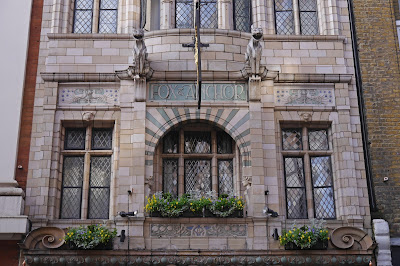Sir William Powell's Almshouses, Fulham
A beautiful day for once and I decide to pursue my interest in almshouses with a Tube-assisted walk in South West London, starting from Putney Bridge tube station. Almost opposite is the church of All Saints. It has a handsome 14th century tower, but the rest of the church, abutting awkwardly against it, is late Victorian, by Sir Arthur Blomfield.
Behind the church, in Church Gate are Sir William Powell's Almshouses. They were originally founded in 1680, but were rebuilt here in 1869 by the architect John P Seddon. As the photo above shows, the site was small and constricting, but Seddon did a great job with the picturesque composition, high pitched roof and dormer windows. Pevsner (writing in 1952) says that these almshouses "should be carefully marked down for preservation". And happily they have been.
The second picture shows the gable end and a tower apparently containing a staircase, adorned with figures of Faith, Hope and Charity.
At this point I decided to head across Putney Bridge in search of a second set of almshouses. But first, on the far side was another interesting church, St Mary's. Like its sister on the other bank this too had an old tower (15th century, with a nice sundial) and an incongruous nave, this time of 1836.
Round the corner in Putney Bridge Road, were Sir Abraham Dawes' Almshouses. These were originally founded in 1648 and rebuilt here, more humbly than the Powell ones, in 1854.
Returning to the Fulham side of the river, I decided to follow a sign to Fulham Palace - I didn't know there was one. You follow the river bank and then turn right to find this lovely entrance courtyard. This part dates back to the early 16th century. It turns out that it was country seat and later the Palace of the Bishops of London, from at least the 11th century up to 1975. It is still owned by the Church of England but managed by a Trust and the local authority.
The rear elevation is very different, late 18th century, with a red brick chapel by William Butterfield over to the left. I didn't go in, but it was a delightful surprise.
For the second part of my walk I took the Tube to Vauxhall. From there I walked South Lambeth Road to Fentiman Road, where I found Sir Noel de Caron's Almshouses. Like the others, these were founded in the 17th century (1618) and rebuilt in a new location in Victorian times (1854). De Caron was a long-serving Dutch ambassador to England.
I had one further target in mind and walked back along South Lambeth Road and along Kennington Lane and then Tyers St. This offered both a City Farm with donkeys and unusually clear view of the MI6 building designed by Terry Farrell.
My destination was Woodstock Court in nearby Newburn Street, set within a massive area of public housing dating mainly from the 1930s. This development dates from 1914 and was built by Prince Edward, Prince of Wales, for old tenants of the Duchy of Cornwall.
Conditions: clear and sunny!
Distance: I walked about 5 miles.
Rating: four stars. Partly what I expected, plus some nice surprises.









































